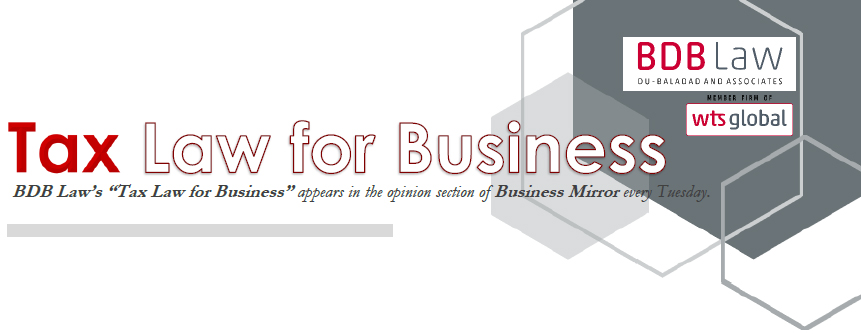

Options and Remedies for Unutilized Advance Income Tax Payments
By Atty. Fulvio D. Dawilan
"A taxpayer who originally opts to carry-over, by ticking the appropriate box in the tax return, may not later on apply for refund. If it does, the refund claim will be denied as the taxpayer itself had opted out of that right. On the other hand, if the taxpayer chooses to reclaim the excess income tax payments through a refund, that is not irrevocable. It may proceed to apply for a refund within the prescribed period. But being not irrevocable, the taxpayer may change its initial choice. And once the carry-over is made, the taxpayer cannot shift back to a refund. ”
 Fulvio D. Dawilan +632 8403 2001 loc.310 |
My colleagues and I had previously written articles on similar topics in this column. But the number of questions raised urges me to provide more clarifications.
There are a number of instances in our tax structure where income taxes are required to be paid in advance. The two usual causes are the quarterly payments and withholding taxes. Both individual and corporate taxpayers are required to file quarterly returns and pay taxes on such returns filed. Also, with the application of the withholding tax system, clients/customers or payors of income are required to deduct and withhold taxes based on prescribed percentages. Being advance income tax payments, the quarterly income tax payments are creditable against the final income tax due of the taxpayer.
 Similarly, the creditable withholding taxes are creditable against the quarterly and final income taxes due.
Similarly, the creditable withholding taxes are creditable against the quarterly and final income taxes due.
When these advance income tax payments are not fully utilized against the resulting final income tax due from the results of operations for the whole taxable year, there is excess income tax payment. The Tax Code allows the taxpayer to choose from two options: (1) refund (cash refund/tax credit certificate) or carry-over to the succeeding taxable periods.
The options had been the subject of a number of controversies between the taxpayers and the tax authority. And these controversies have something to do with the irrevocability of the option, once exercised by the taxpayer. Referring to the most recent interpretation of the Supreme Court on the matter, once the taxpayer opts to carry-over the excess income tax payment, that option becomes irrevocable. The irrevocability rule applies only to the option to carry-over. It does not apply to the refund option.
What does this mean? A taxpayer who originally opts to carry-over, by ticking the appropriate box in the tax return, may not later on apply for refund. If it does, the refund claim will be denied as the taxpayer itself had opted out of that right. On the other hand, if the taxpayer chooses to reclaim the excess income tax payments through a refund, that is not irrevocable. It may proceed to apply for a refund within the prescribed period. But being not irrevocable, the taxpayer may change its initial choice. And once the carry-over is made, the taxpayer cannot shift back to a refund.
So these are the instances where refund will not prosper and the irrevocable carry-over option will prevail: (a) taxpayer ticks the box for carry-over in the income tax return, (b) taxpayer chooses the refund option by marking the appropriate box in the return but actually carries over the excess income tax payment in the succeeding period, (c) taxpayer initially chooses refund but amends and change to carry-over, and (d) taxpayer does not make any choice in the return but actually forwards the excess tax payment to the succeeding period. In sum, regardless of the choice initially made by the taxpayer, once a carryover is chosen or actually made, that will prevail over a refund claim. Incidentally, even if just a portion of the excess income tax payment is actually carried-over, that amounts to a choice for the whole amount.
Will all carry-overs to the quarterly or annual income tax return of the subsequent period affect the original refund choice? Apparently, the revenue regulations mention only the carry-over to the annual income tax returns of the succeeding year that would result in the denial of refund claim.
Zeroing in on the refund remedy, there are at least two changes introduced by the Ease of Paying Taxes (EOPT) Act affecting the refund of erroneously paid taxes (excess income tax payments are treated as erroneously paid taxes for refund purposes). The first one is the introduction of the 180-day period within which the Bureau of Internal Revenue (BIR) should act on the claim.
Prior to the EOPT, the taxpayer applying for a refund of excess income tax payments had to file within two years both for the administrative claim with the BIR and the judicial claim with the Court of Tax Appeals. Because of this 2-year period for both the administrative and judicial claims, there were issues raised on the reasonableness of time given to the BIR to review the application before appealing to the CTA. In essence, what is considered a reasonable time from the filing of the administrative claim to the filing of the judicial claim?
This issue is partly addressed by the 180-day period introduced by the EOPT. Briefly, a taxpayer should file the application with the BIR within 2 years from the payment of the tax. In cases of excess quarterly payments or unutilized creditable withholding taxes, the filing of the annual income tax return is considered the payment of the tax. The BIR is then given a 180-day period from the submission of the documents within which to process and decide on the application. If there is a decision within the 180-day period, the taxpayer may appeal to the CTA within 30 days from receipt of the decision. Of course, if favorable, there will be no further action on the part of the taxpayer. But in case the 180-day period within which the BIR has to decide lapses with no action, the taxpayer may appeal to the CTA already. The implementing revenue regulations added that the administrative remedy becomes moot and academic, and so the BIR will stop processing it. That means that the taxpayer may actually wait for the decision of the BIR. But if that happens, the taxpayer will only rely on the decision of the BIR, whatever the result.
The other important change introduced by the EOPT is with respect to the remedy available to the taxpayer when it dissolves, and there are still unutilized creditable withholding taxes or excess income tax payments. Obviously, since these unutilized income tax payments are accumulated from previous years, these were carried from said earlier years. And following the irrevocability rule, the taxpayer cannot recover them through refund.
The EOPT introduced an exception (to the irrevocability rule) for taxpayers who can no longer carry-over due to dissolution or cessation of business. As they can no longer carry forward the unutilized taxes, they are allowed to apply for refund. And as another exception (to the 180-day rule), the BIR has a period of 2 years from the date of dissolution to decide on the claim.
Given these situations, the choice is on the taxpayer – either to elevate its unacted claim to the CTA or to wait for the actual decision of the BIR, with the hope that it will be favorable.
The author is the Managing Partner of Du-Baladad and Associates Law Offices (BDB Law), a member-firm of WTS Global.
The article is for general information only and is not intended, nor should be construed as a substitute for tax, legal or financial advice on any specific matter. Applicability of this article to any actual or particular tax or legal issue should be supported therefore by a professional study or advice. If you have any comments or questions concerning the article, you may e-mail the author at This email address is being protected from spambots. You need JavaScript enabled to view it. or call 8403-2001 loc 310.



